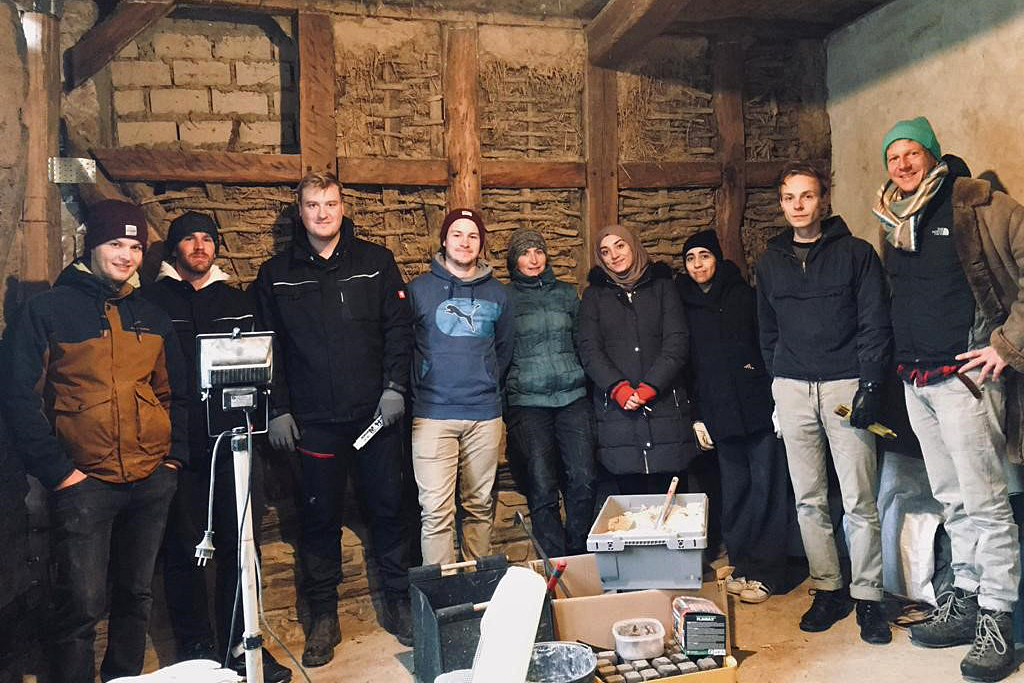Architecture institutes help in the Eifel Students of TU Braunschweig support the renovation of a half-timbered house after the flood disaster
The Eifel region is still heavily affected by the storms and floods during the summer months. The massive damage to the region’s buildings and infrastructure is only now becoming fully apparent. The task now is to rebuild and repair buildings belonging to families who have lost their homes. Architecture students from Technische Universität Braunschweig are also helping. They are supporting the Brandenburg aid campaign “Potsdam helps the Eifel”.

Under the guidance of clay building expert David Moritz (far right), students from the ISU and IBEA institutes at TU Braunschweig recorded the damage to the half-timbered house on site and took measurements. Picture credits: David Moritz/TU Braunschweig
Since the beginning of this week, the first group of students has been in the Eifel together with academic staff to get to work straight away. The focus is on the house of Christina from Kreuzberg on the Ahr. She lives with her sons in a half-timbered house in which the water was four metres high. The clay infills have been destroyed or washed out by the floods, and the house is currently no longer habitable. It must therefore be completely renovated, including its extension.
Since such a project cannot be managed alone, Christina approached Sebastian Frenkel, who started the relief action “Potsdam helps the Eifel”. More than 300,000 euros have already been collected through this, including in the form of technical equipment for drainage and donations in kind, such as generators, tools and building materials. In addition, a growing suport network with various activists and companies has been established in this way.
Many individual fates after the flood disaster
But how did the cooperation between Potsdam’s helpers and Braunschweig’s architecture institutes come about? Sebastian Frenkel told Professor Vanessa Carlow, head of the Institute for Sustainable Urbanism (ISU) at TU Braunschweig and spokesperson of the Core Research Area “Future City”, whom he knew from his school days, about the relief action. For her it was no question that she wanted to support here. “Sebastian has told of many fates on the ground. I was particularly moved by Christina’s, perhaps because I am also a single mother. I wanted to help. Together we developed the idea of taking care of the clay infills in Christina’s house. Since this is also of interest to our students at the Department of Architecture, many of them are now benefiting from the aid project in different ways. I’m totally proud that we were able to recruit so many students for the relief action and the renowned earthen construction expert David Moritz right along with them.”
Christina’s house is being repaired

Warming by the wood stove: In Christina’s house there has been no electricity and no heating since the disaster. Picture credits: David Moritz/TU Braunschweig
This is how the Braunschweig initiative of the ISU started together with the Institute for Building Climatology and Energy of Architecture (IBEA) under the direction of Professor Elisabeth Endres, who comes from the Eifel: “I was immediately moved by the call of Vanessa Carlow and the great commitment of Sebastian Frenkel, and we redesigned the semester program shortly before publication. On the one hand, it’s about my home, and on the other hand, it’s about a building material that is important from our point of view, and which is steadily gaining in importance in the question of resources in the construction industry. That makes it an absolute heart project for me in many ways.”
The respective teams of students and research assistants restore Christina’s house under the expert guidance of the clay construction expert David Moritz as lecturer, supported by the aid network and the people on site. The researchers can later apply their experience and scientific findings to other cases of damage.
For one week, ten students are on site to record the damage and winterize the house, take measurements, and begin coordinating the planning of the repair. In the run-up to the project, the students took part in workshops to learn the basics of building surveying and earthen construction methods. They were introduced to clay as a building material and gained initial insights into various wall constructions and combinations of the building material with other materials. In spring 2022, many helping hands will renovate the clay infill walls in another workshop on site. Until then, the walls can dry and the upcoming work can be planned. This will make it possible to provide energetic and sustainable support within the framework of the initiative in the Eifel, while at the same time providing students with practical experience in earthen construction and also gaining transferable, interdisciplinary scientific knowledge.
For more information, visit www.potsdam-hilft-der-eifel.de and www.sustainableurbanism.org.
The teams include:
Prof. Dr. Vanessa Carlow with Chantal Karadag, Olaf Mumm, Sebastian Schmidt and ISU Team
Prof. Elisabeth Endres with Tobias Pörschke and IBEA Team
Note: The team has agreed on a 2G-Plus rule for cooperation.
